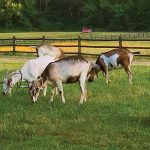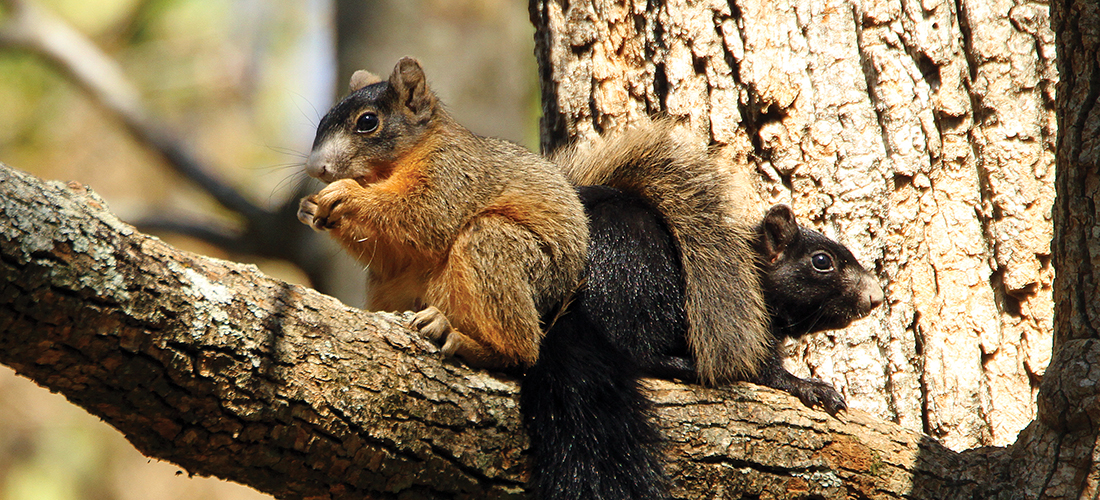
A special family of fox squirrels
Story and Photographs by Todd Pusser
Dappled sunlight, filtered through a canopy of tall trees, danced across clumps of golden-hued wiregrass. The wind was still, and the scent of yellow jessamine and pine hung heavy in the air. Nearby, a pair of brown-headed nuthatches busily excavated a small cavity in a standing, dead pine snag, their incessant, squeaky toy-like chatter breaking the silence of an otherwise quiet April morning. The air temperature hovered around 70 degrees with zero humidity, and there was not a cloud in the sky.
I had been sitting in a small, makeshift blind for nearly two hours, pointing a large telephoto lens, mounted on a tripod, at a natural cavity about 20 feet off the ground in a tupelo tree. The tree stood along a tiny trickle of a creek at the base of a gently sloping hill covered in turkey oak and longleaf pine near the small Moore County town of Eagle Springs.
Two days prior, I had watched a mother fox squirrel move her four young pups to the tupelo tree from a large wooden nest box mounted in a pine along the edge of the yard of my childhood home. I had built the nest box, 20 years before, for course credit in my shop class at Pinecrest High School. I had hoped a family of screech owls would take up residence in the box, but was pleasantly surprised when a female fox squirrel chose to raise her family there instead.
Fox squirrels are among my favorite animals, and I have been fascinated by them since I was a little kid. I vividly recall standing at our kitchen window when I was just 5 years old, staring out into the backyard at a solid black fox squirrel, with a brilliant white nose, standing on its hind legs grasping a pine cone at the base of a tall longleaf. The squirrel, nearly the size of a house cat, proceeded to shred each and every sharp petal off the cone to get at the tasty seeds inside. It was like watching a scene straight out of Mutual of Omaha’s Wild Kingdom, a popular television show at the time. I had never seen such an animal before, and the encounter left an indelible mark on my young mind, cementing a lifelong obsession with the natural world and all its marvels.
North America’s largest tree squirrels, fox squirrels come in a variety of colors, ranging from gray to reddish orange to solid black, and every combination in between. Most examples have a white nose and white ears. Fox squirrels are rather uncommon in North Carolina. Though they range from the mountains to the coast, the species seems most abundant in the Sandhills, where longleaf pine trees are prevalent. Tee it up on any of the area golf courses and you will likely see fox squirrels running across the fairways, their long flowing tails — a characteristic that gives the species its common name — bouncing up and down as they disappear. Over the years, I have seen many fox squirrels scampering around the links of Pinehurst Country Club, as well as those at Foxfire, Seven Lakes and Whispering Pines.
Though fox squirrels have a broad diet that includes acorns, persimmons and mushrooms, they relish longleaf pine cone seeds. A fox squirrel’s large size gives it a competitive advantage over their smaller cousin, the gray squirrel, allowing the species to easily rip apart the massive longleaf pine cones to get at the nutritious and caloric-rich seeds inside.
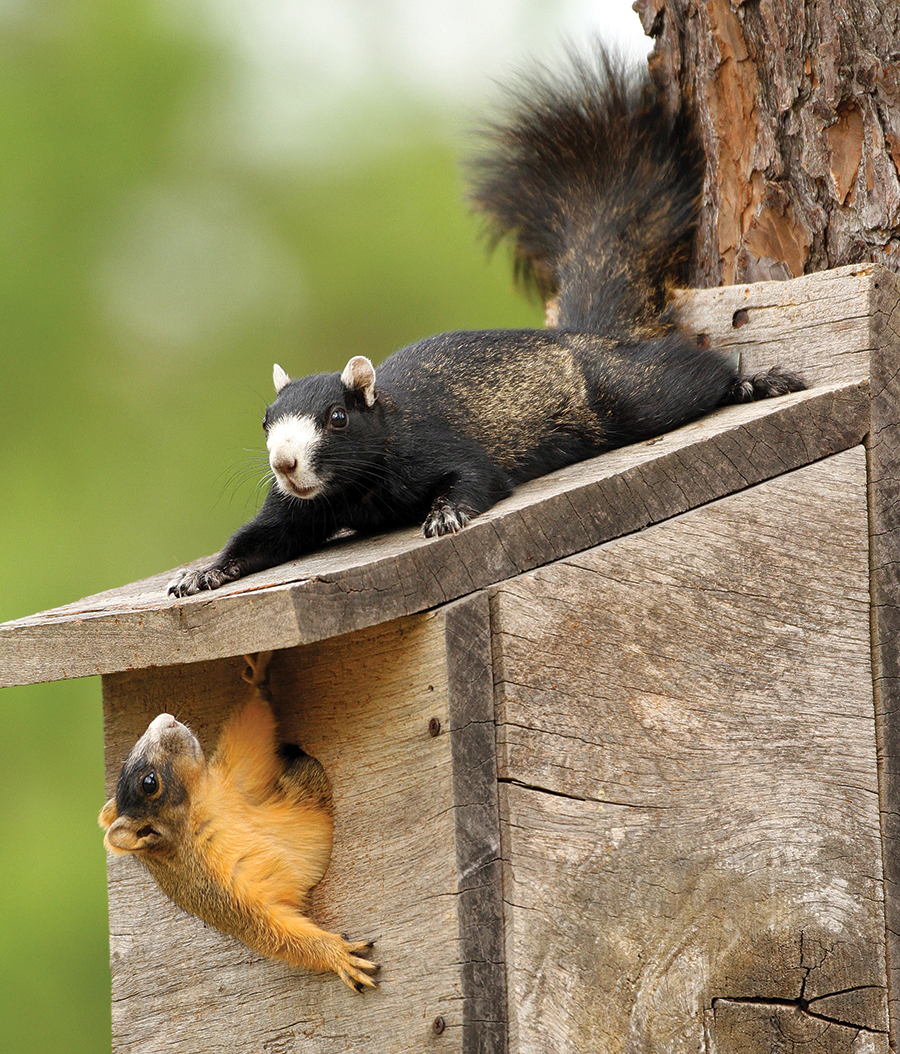
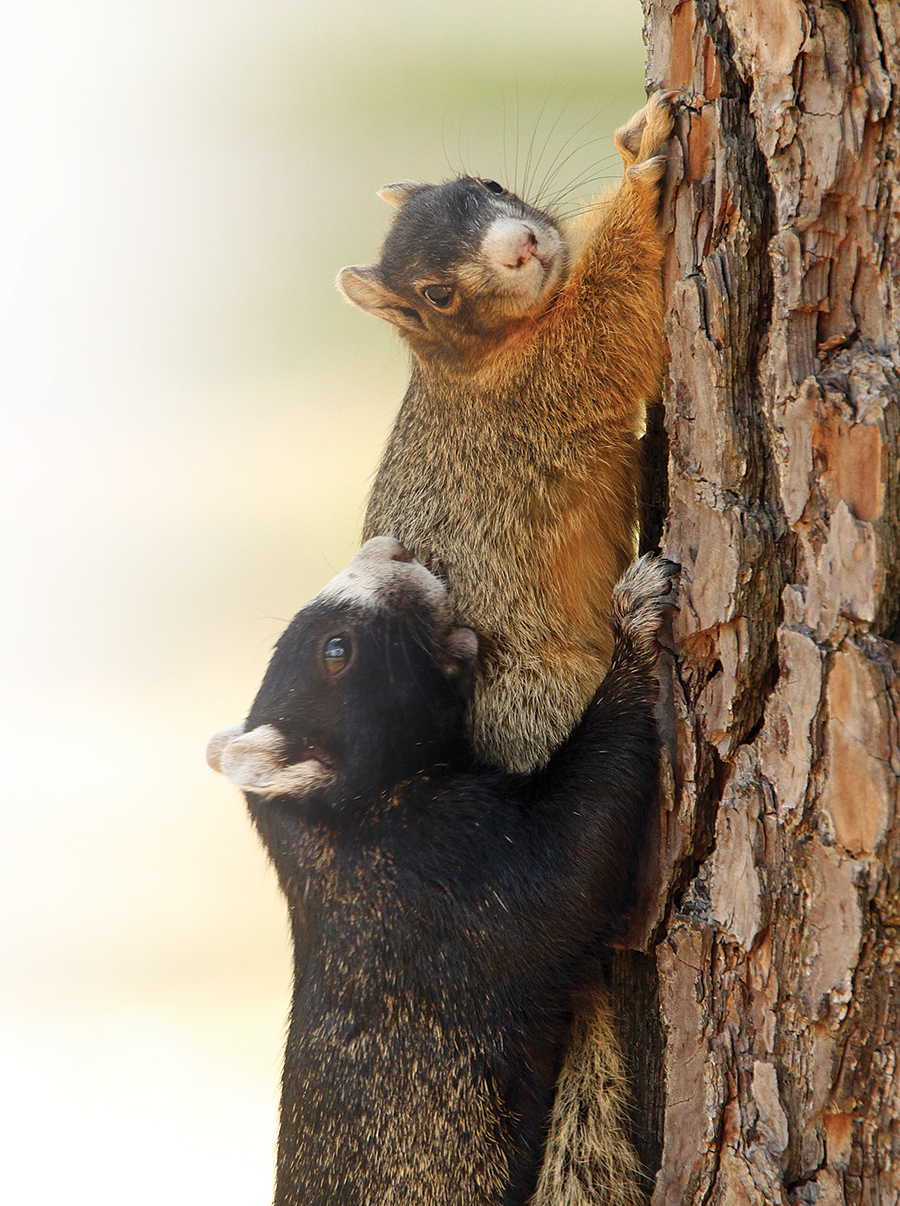
Back in the blind, my mind was starting to wander and my lower back was aching from sitting so long in one position. Finally, I noticed a white-tipped nose sticking out from the cavity. Before long, a pair of young fox squirrels, one solid black and the other reddish orange, poked their heads out of the hole, soaking up the morning sun. Like youngsters everywhere, they were extremely rambunctious, and I found myself repeatedly laughing out loud at their antics. The pair would scamper all over one another, pushing their paws into each other’s faces and constantly grabbing at the other’s tail.
It was the young pups’ mother, a distinct black squirrel with a grizzled gray back, white nose and white ears, who led me to this cavity tree three years prior. That April, she raised four pups in the wooden nest box, and I spent countless hours sitting and watching their behavior. The following spring, like clockwork, she returned to the same nest box at nearly the same time and raised four more pups. During that particular year, the forest was overflowing with an abundance of acorns and pine cones, and I was surprised to see the mother fox squirrel return, yet again, to the nest box in October and raise three more pups.
Like mothers everywhere, she was extremely hard-working and diligent with the care of her young. Most days would find her stretched out on top of the nest box, patiently watching the surrounding area, while her pups crawled all over her back. Occasionally she would groom or nurse them out in the open. The raucous alarm calls of crows harassing a nearby hawk would cause the mother squirrel to issue a sharp warning bark and immediately rush her family back inside the safe confines of the nest box.
As the pups matured, they would scamper off the nest box, up the trunk of the pine, into nearby tree branches. It was at this point in their life cycle that the mother squirrel would move the pups, one by one, from the nest box in the yard to the natural cavity of the tupelo tree standing by the creek, a journey of nearly 200 yards.
When I first observed this behavior, I was intrigued, and did not immediately understand what was happening. It was early April, and I had watched the pups frolic around the nest box for nearly three weeks. One morning, the pups remained inside the box while mother squirrel was out foraging on her own. When she returned, she climbed up the tree to the top of the nest box and started waving her long black tail rapidly up and down while making a low, throaty, whirring sound with her mouth.
Almost immediately, a young squirrel stuck its head out of the box and then climbed up on top to join her. Mother squirrel gently grabbed it by the nape of the neck with her mouth and curled the youngster into a tight ball with her front paws. She then jumped off the box into a nearby pine and quickly scampered down, headfirst, with the young squirrel tightly clamped in her jaws. Once on the ground, she let the youngster go and moved a few feet away, still moving her tail rapidly up and down, and making that same, low, muttering sound.
It took some persuasion, but she eventually coaxed the young pup to follow her, and the pair navigated the edge of the yard and quickly disappeared into the woods. She returned a half hour later and repeated the same behavior with the next pup and then the next. With just one pup remaining in the nest box, curiosity got the best of me, and I grabbed a pair of binoculars and waited quietly at the edge of the yard for mother squirrel to return. When she did, I followed at a distance, careful not to disturb her, as she led the last pup down the hill, through dense patches of wire grass, to the cavity in the tupelo tree, where its siblings waited.
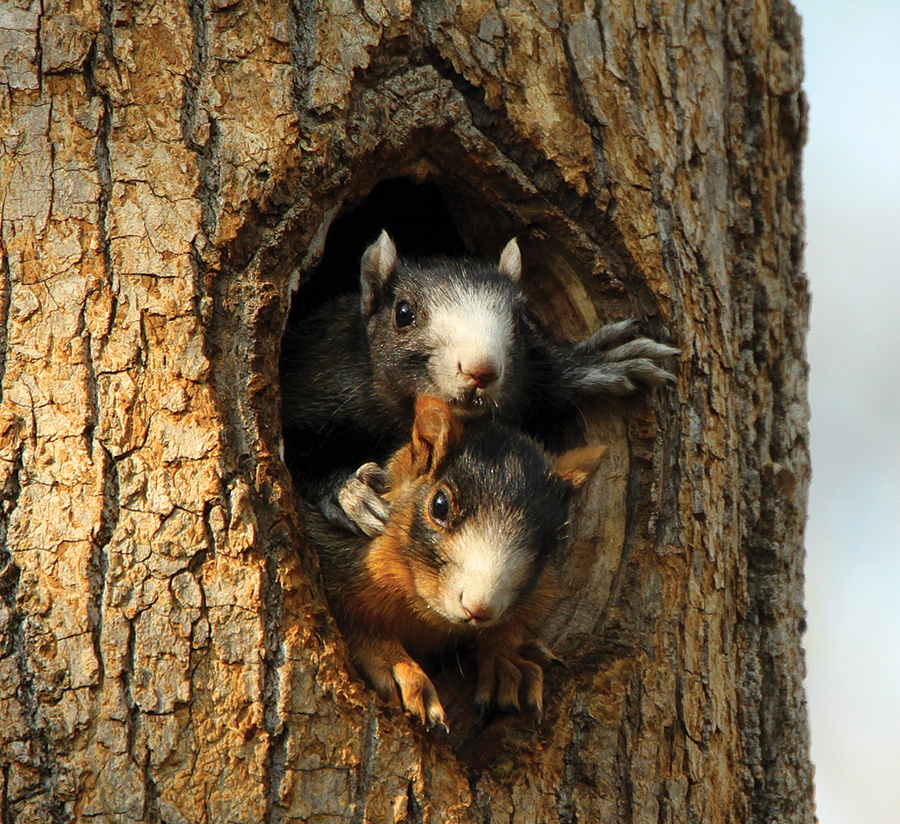
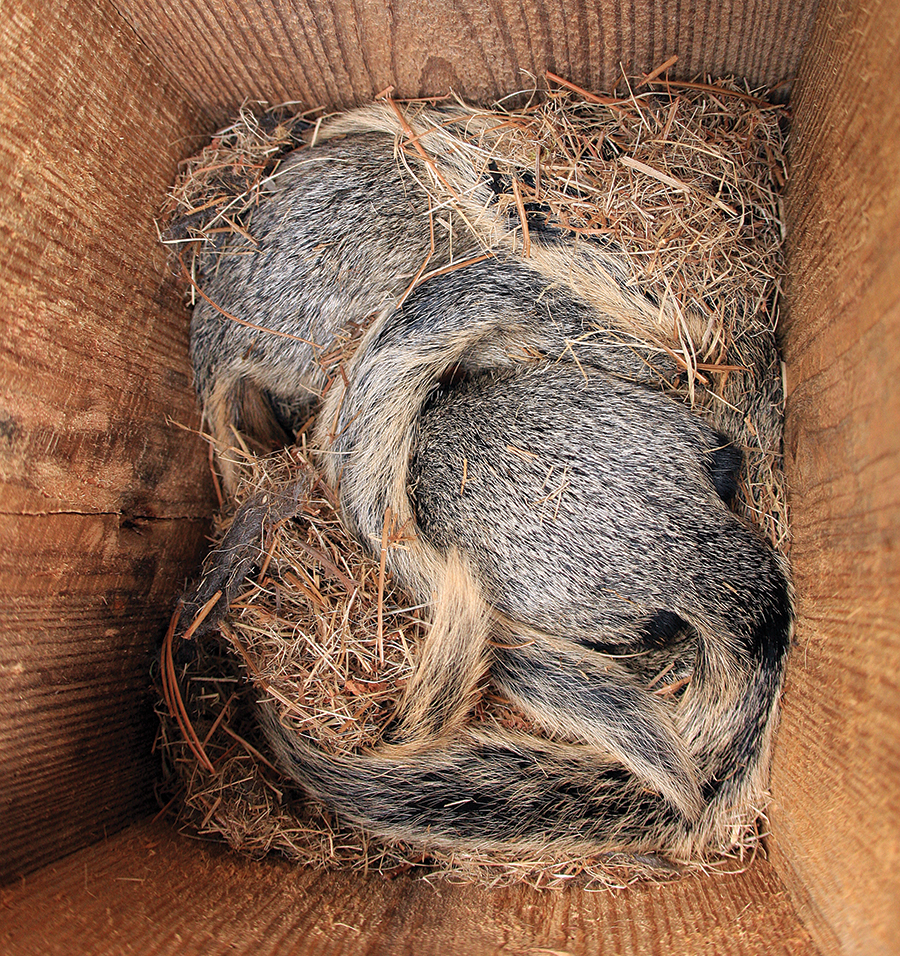
The long journey on the ground from the nest box to the cavity tree seemed risky, potentially exposing the young to predators like hawks or coyotes, but the mother fox squirrel obviously knew what she was doing. She performed the same behavior with each of the four broods I watched her raise over the next three years. I can only assume the nest box became too crowded for the rapidly maturing squirrels, and that the natural cavity in the gum tree provided much needed space for the family to move around and grow.
By now, the pair of young squirrels that I had been watching in the tupelo tree climbed out of the cavity onto a nearby branch, where they sat quietly together. Still concealed in the blind, I slowly stretched out my stiff back and quietly adjusted the settings on my camera. As I did, another young squirrel with a mottled gray coat and white nose stuck its head out of the cavity, followed by a fourth, also gray-colored, but with a distinct black face.
The last squirrel to emerge from the cavity was the reason I had been patiently sitting and watching for over two hours. That the young pup was alive and healthy was a testament to the resiliency and resourcefulness of the mother squirrel I had come to know so well over the years. The gray pup with the black face was not one of her offspring.
Earlier in the spring, when the mother fox squirrel was raising pups in her usual nest box, a second female fox squirrel was occupying another box I had placed in a pine on the opposite side of the 2-acre yard. That female was light gray in color, and had a white belly and pale nose. Her frequent comings and goings led me to believe she also had young of her own. It was the first and still only time I have seen two female fox squirrels simultaneously raising families in the yard.
One afternoon, much to my dismay, I found the gray female lying along the shoulder of the road near the yard, a victim of a hit and run with an automobile. Her swollen mammary glands indicated that she was indeed nursing young. I immediately fetched a ladder and climbed up the tree to the nest box she had been using and looked inside. Curled up in a ball, on a bed of pine needles, was a single gray fox squirrel pup with a black face, so young, its eyes had not fully opened.
Instead of taking the orphaned pup to a veterinarian or wildlife rehabber, I decided to take it to the nest box of the well-known black squirrel on the opposite side of yard. It was a calculated risk, but I thought that the tiny pup’s best chance of survival would be better with an experienced female of its own species. Climbing the tree, I peered into the nest box, and saw three young pups, all roughly the same size and age as the orphan in my hands, curled up tightly together. As carefully as I could, I placed the pup inside the box where it quickly snuggled up with the others.
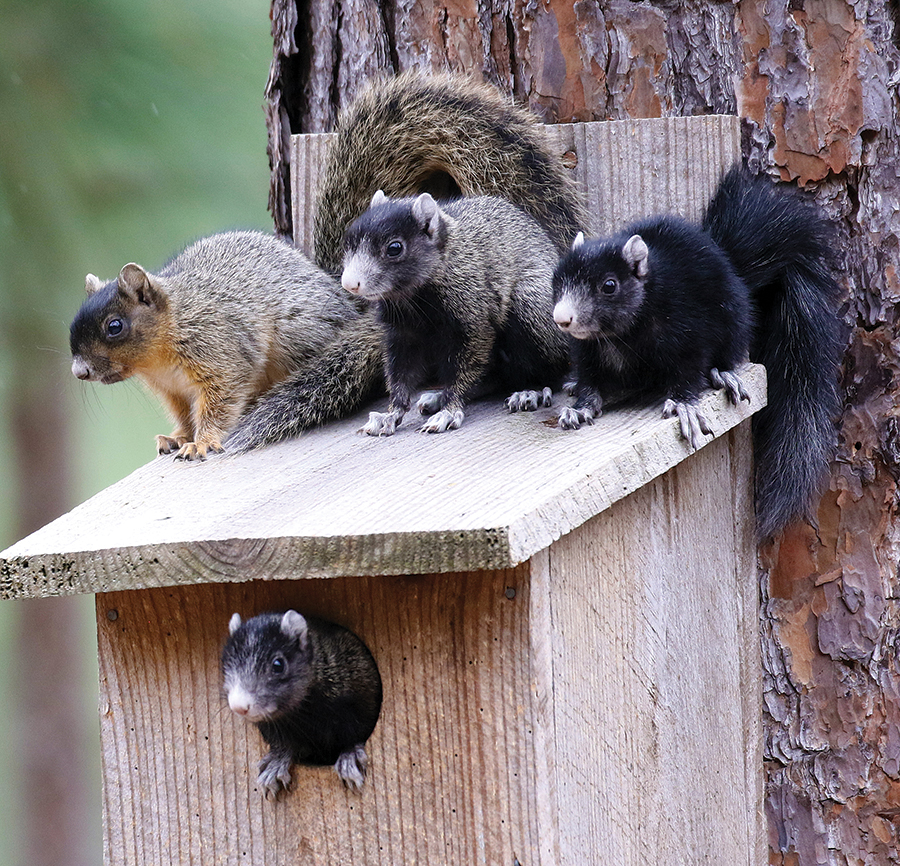
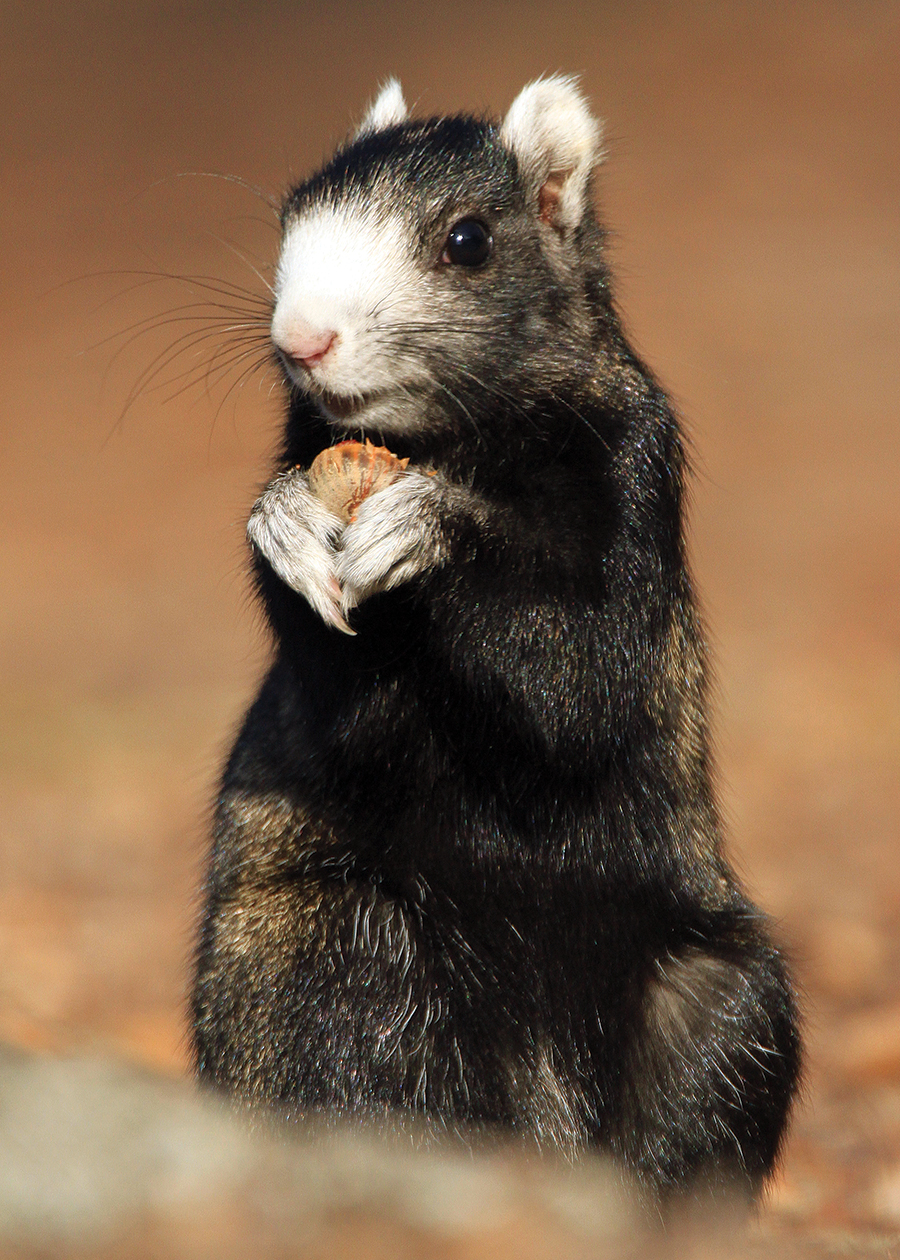
Descending the tree, I retreated to the far corner of the yard, to watch for the mother squirrel to return, anxious to see if she would adopt the orphan pup. She had been away from the box most of the morning, likely foraging for breakfast. However, there was no need to worry. In no time at all, she returned to the box and readily accepted the orphan as her own, and was soon nursing it along with her own pups.
Back at the tupelo tree, I continued to watch the young squirrels for the remainder of the morning and much of the afternoon. Mother squirrel returned about mid-afternoon, and I decided to pack up my gear when the family settled back inside the tree cavity.
The events of that day took place over 10 years ago, and it ended up being the last time I saw the mother fox squirrel. The following spring I waited with anticipation for her return to the nest box, but she never appeared. It was the same the following year.
On average, female fox squirrels live about 12 years in the wild. Perhaps those years I had watched her raise four different families of baby squirrels were near the end of her life. Perhaps she succumbed to disease or fell victim to a red-tailed hawk. Perhaps she simply found a different spot, another tree cavity, in which to raise a family.
After several years of not seeing any fox squirrels at the nest boxes in the yard, just this past spring a different female, solid black and lacking a grizzled gray back, moved into the old nest box. I like to think it was one of the old mother squirrel’s offspring returning home to raise a family of her own. PS
Naturalist and photographer Todd Pusser, who grew up in Eagle Springs, is a regular contributor to PineStraw. He works to document the extraordinary diversity of life both near and far. His images can be found at www.ToddPusser.com.

